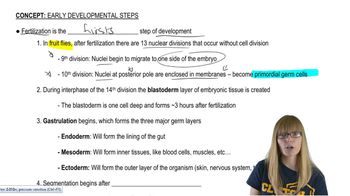Which of the following HOX clusters are responsible for forming the abdominal in Drosophila development?
Table of contents
- 1. Introduction to Genetics51m
- 2. Mendel's Laws of Inheritance3h 37m
- 3. Extensions to Mendelian Inheritance2h 41m
- 4. Genetic Mapping and Linkage2h 28m
- 5. Genetics of Bacteria and Viruses1h 21m
- 6. Chromosomal Variation1h 48m
- 7. DNA and Chromosome Structure56m
- 8. DNA Replication1h 10m
- 9. Mitosis and Meiosis1h 34m
- 10. Transcription1h 0m
- 11. Translation58m
- 12. Gene Regulation in Prokaryotes1h 19m
- 13. Gene Regulation in Eukaryotes44m
- 14. Genetic Control of Development44m
- 15. Genomes and Genomics1h 50m
- 16. Transposable Elements47m
- 17. Mutation, Repair, and Recombination1h 6m
- 18. Molecular Genetic Tools19m
- 19. Cancer Genetics29m
- 20. Quantitative Genetics1h 26m
- 21. Population Genetics50m
- 22. Evolutionary Genetics29m
14. Genetic Control of Development
Developmental Patterning Genes
Problem 4b
Textbook Question
Early development in Drosophila is atypical in that pattern formation takes place in a syncytial blastoderm, allowing free diffusion of transcription factors between nuclei. In many other animal species, the fertilized egg is divided by cellular cleavages into a larger and larger number of smaller and smaller cells.
How must the model that describes Drosophila development be modified for describing animal species whose early development is not syncytial?
 Verified step by step guidance
Verified step by step guidance1
Understand the key difference between Drosophila development and other animal species' development: Drosophila development occurs in a syncytial blastoderm, where nuclei share a common cytoplasm, allowing transcription factors to diffuse freely. In contrast, other species undergo cellular cleavage, where individual cells are formed, and transcription factors are restricted to their respective cells.
Recognize that in a syncytial blastoderm, the model assumes that transcription factors can freely diffuse and establish gradients across the shared cytoplasm. This allows for the formation of positional information based on these gradients.
For species with cellular cleavage, the model must account for the fact that transcription factors are confined within individual cells. This means that diffusion between cells is not possible, and positional information must be established through mechanisms such as cell signaling or localized transcription factor production.
Incorporate mechanisms like cell-cell communication (e.g., signaling pathways such as Notch, Wnt, or Hedgehog) into the model to explain how cells coordinate their development in the absence of a shared cytoplasm.
Adjust the model to include the role of cell membranes as barriers to diffusion and emphasize the importance of localized gene expression and intercellular signaling in establishing developmental patterns in species with cellular cleavage.
 Verified video answer for a similar problem:
Verified video answer for a similar problem:This video solution was recommended by our tutors as helpful for the problem above
Video duration:
2mPlay a video:
Was this helpful?
Key Concepts
Here are the essential concepts you must grasp in order to answer the question correctly.
Syncytial Blastoderm
A syncytial blastoderm is a stage in early embryonic development where multiple nuclei share a common cytoplasm without cellular boundaries. In Drosophila, this allows for the free diffusion of transcription factors, facilitating coordinated gene expression across the embryo. Understanding this concept is crucial for comparing it to other developmental models where individual cells are formed early on.
Recommended video:
Guided course

Drosophilia Development
Cellular Cleavage
Cellular cleavage refers to the series of rapid mitotic divisions that occur after fertilization, resulting in the formation of smaller cells called blastomeres. In many animal species, this process leads to a multicellular embryo from the outset, contrasting with the syncytial development seen in Drosophila. Recognizing how cleavage patterns influence development is essential for modifying models to fit non-syncytial organisms.
Recommended video:
Guided course

Post Translational Modifications
Transcription Factors
Transcription factors are proteins that regulate the expression of specific genes by binding to nearby DNA. In the context of early development, they play a critical role in determining cell fate and pattern formation. In a syncytial environment, these factors can diffuse freely, while in cellular cleavage models, their distribution and activity must be tightly regulated within individual cells, necessitating adjustments to developmental models.
Recommended video:
Guided course

Eukaryotic Transcription
Related Videos
Related Practice
Multiple Choice
523
views
1
rank


